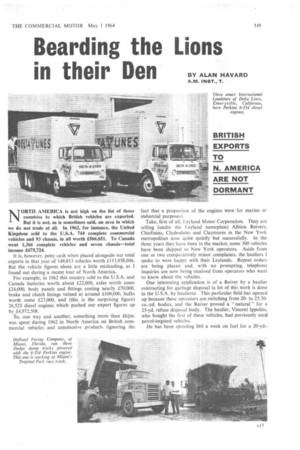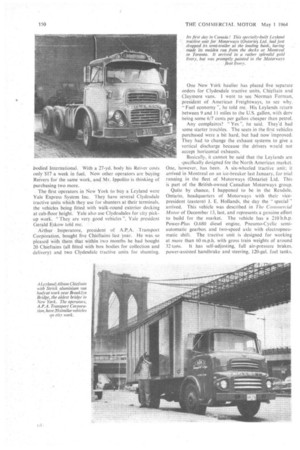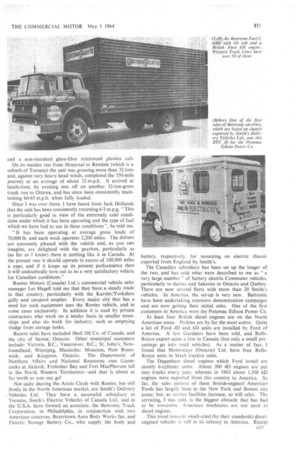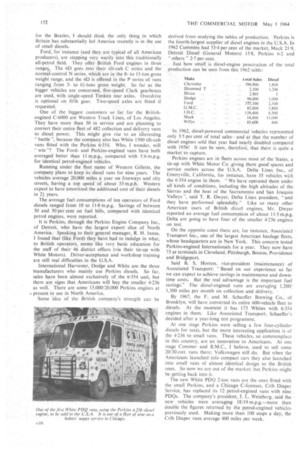Bearding the Lions
Page 151

Page 152

Page 153

Page 154

If you've noticed an error in this article please click here to report it so we can fix it.
in their Den BY ALAN HAVARD
A.M. INST., T.
NORTH AMERICA is not high on the list of those countries to which British vehicles are exported. But it is not, as is sometimes said, an area in which we do not trade at all. In 1962, for instance, the United Kingdom sold to the U.S.A. 744 complete commercial vehicles and 93 chassis, in all worth £566,651. ' To Canada went 1,366 complete vehicles and seven chassis—total income £675,724.
It is, however, petty cash when placed alongside our total exports in that year of 149,813 vehicles worth £113,958,046. But the vehicle figures alone are a little misleading, as I found out during a recent tour of North America.
For example, in 1962 this country sold to the U.S.A. and Canada batteries worth about £22,000, axles worth some £24,000, body panels and fittings costing nearly £70,000, brake and clutch linings valued at around £109,000, bulbs worth some £27,000, and (this is the surprising figure) 26,523 diesel engines which pushed our export figures up by £4,972,508.
So, one way and another, something more than £61m. was spent during 1962 in North America on British commercial vehicles and automotive products (ignoring the fact that a proportion of the engines were for marine or industrial purposes).
Take, first of all, Leyland Motor Corporation. They are selling (under the Leyland nameplate) Albion Reivers, Chieftains, Clydesdales and Claymores in the New York metropolitan area quite quietly but successfully. In the three years they have been in the market, some 300 vehicles have been shipped to New York operators. Aside from one or two comparatively minor complaints, the hauliers I spoke to were happy with their Leylands. Repeat orders are being placed and, with no prompting, telephone inquiries are now being received from operators who want to know about the vehicles.
One interesting application is of a Reiver by a haulier contracting for garbage disposal (a lot of this work is done in the U.S.A. by hauliers). This particular field has opened up because these operators are switching from 20to 25/30cu.-yd. bodies, and the Reiver proved a " natural " for a 25-yd. refuse disposal body. The haulier, Vincent Ippolito, who bought the first of these vehicles, had previously used petrol-engined vehicles.
He has been spending $60 a week on fuel for a 20-yd. bodied International. With a 27-yd. body his Reiver costs only $17 a week in fuel. Now other operators are buying Reivers for the same work, and Mr. lppolito is thinking of purchasing two more.
The first operators in New York to buy a Leyland were Yale Express System Inc. They have several Clydesdale Li-active units which they use for shunters at their terminals, the vehicles being fitted with Walk-round exterior decking at cab-floor height.Yale also use Clydesdales for city-pickup Work. ." They are very good vehicles ", Yale president
Gerald ESkow told me. .
Arthur • Imperatore, president of A.P.A. -Transport CorpOration, bought five Chieftains last year. He was, so pleased with them that within two Months he had bought 20 Chieftains (all fitted with box bodies for collection and delivery) and two Clydesdale tractive units for shunting. One New York haulier has placed five separate orders for Clydesdale tractive units, Chieftain and Claymore vans. I went to see Norman Forman, president of American Freightways, to see why. " Fuel economy ", he told me. His Leylands return between 9 and 11 miles to the U.S. gallon, with dery being some 6/7 cents per gallon cheaper than petrol.
Any complaints? " Yes ", he said. They'd had some starter troubles. The seats in the first vehicles purchased were a bit hard, but had now improved. They had to change the exhaust systems to give a vertical discharge because the drivers wauld not accept horizontal exhausts.
Basically, it cannot be said that the Leylands are specifically designed for the North American market. One, however, has been. A six-wheeled tractive unit; it arrived in Montreal on an ice-breaker last January, for trial running in the fleet of Motorways (Ontario) Ltd. This is part of the British-owned Canadian Motorways group.
Quite by chance, I happened to be in the Rexdale, Ontario, headquarters of Motorways with their vicepresident (eastern) J. E. Hollands, the day the " special arrived. This vehicle was described in The Commercial Motor of December 13, last, and represents a genuine effort to build for the market. The vehicle has a 21013.h.p. Power-Plus 0.680 diesel engine, Pneurno-Cyclic semiautomatic gearbox and two-speed axle with electropneumatic shift. The tractive unit is designed for working at more than 60 m.p.h. with gross train weights of around
32 tons. It has self-adjusting, full air-pressure brakes, power-assisted handbrake and steering, 120-gal. fuel tanks. and a non-standard glass-fibre reinforced plastics cab.
On its maiden run from Montreal to Rexdaie (which is a suburb of Toronto) the unit was grossing more than 32 tons and, against very heavy head winds, completed the 350-mile journey at an average of about 32 m.p.h. It arrived at lunch-time, by evening was off on another 32-ton-gross trunk run to Ottawa, and has since been consistently maintaining 60-65 m.p.h. when fully loaded.
Since 1 was over there, I have heard from Jack Hollaruls that the unit has been consistently returning 6.3 m.p.g. "This is particularly good in view of the extremely cold conditions under which it has been operating and the type of fuel which we have had to use in these conditions ", he told me.
"It has been operating at average gross loads of 70,000 lb. and each week operates 2,200 miles. The drivers are extremely pleased with the vehicle and, as you can imagine, are delighted with the gearbox, particularly as (so far as 1 know) there is nothing like it in Canada. At the present rate it should operate in excess of 100,000 miles a year, and if it keeps up its present performance then it will undoubtedly turn out to be a very satisfactory vehicle for Canadian conditions."
Rootes Motors (Canada) Ltd.'s commercial vehicle sales manager Les Hagell told me that they have a steady trade in that country, particularly with the Karrier/Yorkshire gully and cesspool emptier. Every major city that has a need for such equipment uses the Rootes vehicle, and in some cases exclusively. In addition it is used by private contractors who work on a tender basis in smaller townships and also do work for industry, such as emptying sludge from storage tanks.
Recent sales have included Shell Oil Co. of Canada, and the city of Sarnia, Ontario. Other municipal customers include: Victoria, B.C.; Vancouver, B.C.; St. John's, Newfoundland; Winnipeg, Manitoba; Moncton, New Brunswick; and Kingston, Ontario. The Department of Northern Affairs and National Resources uses Gamecocks at Aklavik, Frobisher Bay and Ron MacPherson (ail in the North Western Territories)—and that is about as far north as you can go!
Not quite sharing the Arctic Circle with Rootes, but still firmly in the North American market, are Smith's Delivery . Vehicles Ltd. They have a successful subsidiary in Toronto, Smith's Electric Vehicles of Canada Ltd.. and in the U.S.A. have formed an associate, the 13attronie Truck Corporation, in Philadelphia, in conjunction with two American concerns, Boyertown Auto Body Works Inc. and Electric Storage Battery Co., who supply the body and
battery, respectively., for mounting on electric chassis exported from England by Smith's.
The Canadian subsidiary has been set up the longer of the two, and has sold what were described to me as "a very large number " of battery electric Commuter vehicles, particularly to dairies and bakeries in Ontario and Quebec. There are now several fleets with more than 20 Smith's vehicles. In America, the set-up is very new. Battronic have been undertaking extensive demonstration campaigns and are now getting their initial sales. One of the first customers in America were the Potomac Edison Power Co.
At least. four British diesel engines are on the North American scene. Perkins are by far the most active. Quite a lot of Ford 4D and 6D 'units are installed by Ford of America. A few Gardners have been sold. and Roils
Royce export quite a few to Canada (but only a small percentage go into road vehicles). As a matter of fact, l found that Motorways (Ontario) Ltd. have four RollsRoyce units in Mack tractive units.
The Dagenham diesel engines which Ford install are mostly 6-cylinder units. About 200 4D engines are put into trucks every year, whereas in 1963 about 1,100 6D engines were exported from this country to America. So far, the sates pattern of these British-engined American Fords has largely been in the New York and Boston city areas; but, as service facilities increase, so will sales. The servicing, I was told, is the biggest obstacle that has had to be . overcome American mechanics are not used to diesel engines.
This trend towards small-sized (by their standards) dieselengined vehicles is still in its infancy in America, Except for the Beatles, I should think the only thing in which Britain has substantially led America recently is in the use of small diesels.
Ford, for instance (and they are typical of all American producers), are stepping very warily into this traditionally all-petrol field. They offer British Ford engines in three ranges. The 6D goes into their tilt-cab C series and the normal-control N series, which are in the 8to 11-ton gross weight range, and the 4D is offered in the P series of vans ranging from 3to 6f-tons gross weight. So far as the bigger vehicles are concerned, five-speed Clark gearboxes are used, with single-speed Timken rear axles. Overdrive is optional on fifth gear. Two-speed axles are fitted if requested.
One of the biggest customers so far for the Britishengined C-6000 are Western Truck Lines, of Los Angeles. They have more than 50 in service and are planning to convert their entire fleet of 482 collection and delivery vans to diesel power. This might give rise to an interesting battle ", because the company also has White 1500 tilt-cab vans fitted with the Perkins 6.354. Who, I wonder, will
win"? The Fordand Perkins-engined vans have both averaged better than 11 m.p.g., compared with 56 m.p.g. for identical petrol-engined vehicles.
Running under the fleet name of Western Gillette, the company plans to keep its diesel vans for nine years. The vehicles average 20,000 miles a year on freeways and city streets, having a top speed of about 53 m.p.h. Western expect to have amortized the additional cost of their diesels in 21 years.
The average fuel consumptions of ten operators of Ford diesels ranged from 10 to 11-8 m.p.g. Savings of between 30 and 50 per cent on fuel bills, compared with identical petrol engines, were reported.
It is Perkins, through the Perkins Engine Company Inc., of Detroit, who have the largest export slice of North America. Speaking to their general manager, R. H. Jansa, 1 found that (like Ford) they have had to indulge in what, to British operators, seems like very basic education for the staff of their 46 district offices (via their tie-up with White Motors). Driver-acceptance and workshop training are still real difficulties in the U.S.A.
International Harvester, Dodge and White are the three Manufacturers who mainly use Perkins diesels. So far, sates have been almost exclusively of the 6-354 unit, but there are signs that Americans will buy the smaller 4-236 as well. There are some 15,000/20,000 Perkins engines at present in use in North America.
Some idea of the British company's strength can be
derived from studying the tables of production. Perkins is the fourth-largest supplier of diesel engines in the U.S.A. In 1962 Cummins had 53.4 per cent of the market; Mack 21-9, Detroit Diesel (General Motors) 15-8, Perkins 6-2 and " others 2-7 per cent.
Just how small is diesel-engine penetration of the total production can be seen from this 1962 table: In 1962, diesel-powered commercial vehicles represented only 3-5 per cent of total sales—and at that the number of diesel engines sold that year had nearly doubled compared with 1956! It can be seen, therefore, that there is quite a market to capture.
Perkins engines are in fleets across most of the States, a tie-up with White Motor Co. giving them good sparesand service outlets across the U.S.A. Delta Lines Inc., of Emeryville, California, for instance, have 35 vehicles with the 6-354 engine in them. "We have operated them under all kinds of conditions, including the high altitudes of the Sierras and the heat of the Sacramento and San Joaquin Valleys said T. R. Dwyer, Delta Lines president, "and they have performed splendidly.Like so many other American users of British diesel engines, Mr. Dwyer reported an average fuel consumption of about 11-5 m.p.g. Delta are going to have four of the smaller 4-236 engines on test.
On the opposite coast there are, for instance, Associated Transport Inc., one of the largest American haulage fleets, whose headquarters are in New York. This concern tested Perkins-engined Internationals for a year. They now have 75 at terminals in Cleveland, Pittsburgh, Boston. Providence and Bridgeport.
Said B: S. Horton, vice-president (maintenance) of Associated Transport: Based on our experience so far we can expect to achieve savings in maintenance and downtime costs. But the real advantage is the important fuel savings." The diesel-e'ngined vahs are averaging 1;200/ 1,500 miles per month on collection and delivery.
By 1967, the F. and M. Schaeffer Brewing Co., of Brooklyn, will have converted its entire 600-vehicle fleet to diesels. At the moment it has 175 Whites with 6.354 engines in them. Like Associated Transport, Schaeffer's decided after a year-long test programme.
At one stage Perkins were selling a few four-cylinder diesels for taxis, but the more interesting application is of the 4-236 to small vans. These vehicles, so commonplace in this country, are an innovation to Americans. At one stage Commer and B.M.C., I believe, used to sell some 20/30 cwt. vans there: Volkswagen still do. But when the Americans launched ido compact cars they also launched into small vans of almost identical design to the British ones. So now we are out of the market: but Perkins might be getting back into it.
The new White PDQ 2-ton vans are the ones fitted with the small Perkins, and a Chicago C-licensee, Crib Diaper Service, has replaced its 12 petrol-engined vans with nine PDQs. The company's president, J. L. Weinberg, said the new vehicles were averaging 18/19 m.p.g.—more than double the figures returned by the petrol-engined vehicles previously used. Making more than 100 stops a day, the Crib Diaper vans average 400 miles per week.




















































































































































































































































